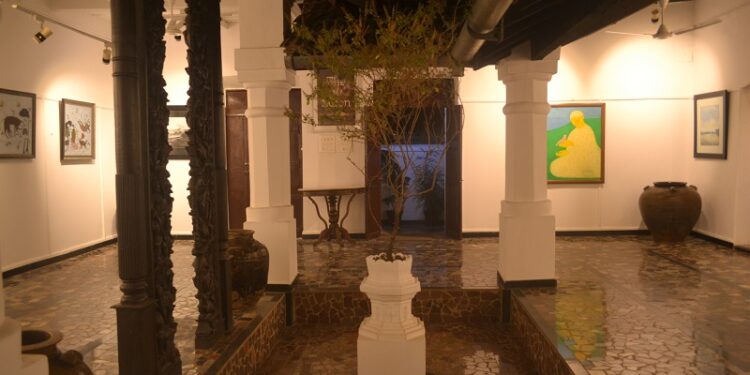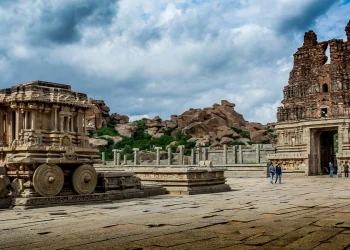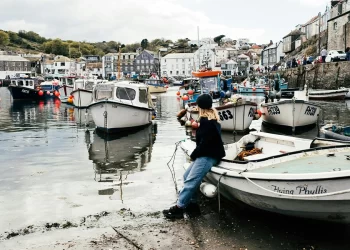By RUTUJA SUNIL ULHE
GOA, A STATE IN WESTERN INDIA HAS AN OPULENT CHARM FROM ITS HISTORY OF COHESIVE AMALGAMATION OF THE PORTUGUESE (FOR AROUND 450 YEARS) AND THE INDIAN CULTURE. IT WAS LIBERATED IN 1961 FROM THE PORTUGUESE RULE AS AN INDEPENDENT STATE IN FREE INDIA. STRETCHING ACROSS THE WESTERN COAST, IT IS 3702 SQUARE KILOMETERS AREA WISE. THE STRETCH OF ARABIAN SEA ENCOMPASSES THE BEAUTIFUL BEACHES, WHICH IS THE USP OF GOA, I.E. THE UNIQUE SELLING POINT.

WHEN ONE SPEAKS OR READS ABOUT GOA, IT IS ALWAYS ABOUT THE BEACHES, LOCAL CUISINE AND THE COASTAL LIVELIHOOD. HAVE YOU EVER WONDERED ABOUT THE ARCHITECTURE OF THE GOAN HOUSES? NOT MUCH, RIGHT?

The architecture in the state of Goa is highly influenced by its impactful colonial legacy. The independent courtyard houses were usually meant for joint families. Constructed using local material like red laterite stone, wood and terracotta oyster-shell for windows, inner courtyards, protruding balcaos, pitched roof is what created the “Goan identity”.
The very existence of inner courtyard houses stretches across India, but are termed differently in different states like Nalukettu in Kerala, Wada in Maharashtra, Haveli in North India, Rabari in West Bengal etc.

Courtyard houses have existed for over thousands of centuries since the Neolithic era. The courtyards in a built form not only offers comfort in terms of providing ample daylight and fresh air but also security and privacy adding on to its relevance in the domain of public, semi-public and private.

The ancient civilizations of Mesopotamia, Indus Valley, Egypt, China and even the European empires like the Greek and Roman all have had the evidence of courtyard typology in their built forms. The character of the courtyard would rather be considered as a ‘timeless’ feature in the history of architecture.
Panaji or Panjim being the state capital has a strong presence of numerous timeless heritage courtyard houses. I remember strolling around in one of the most beautiful locations of Panjim, the Fontainhas precinct, as suggested by a local Goan friend and research guide – Ar. Talullah D’silva.
Fontainhas is Asia’s only Latin Quarter, which is predominantly one of the oldest catholic precincts with a rich history and a distinctive blend of Portuguese and Indian culture. It is located in the heart of Panjim city in between Ourem creek and Altinho hill. The name ‘Fontainhas’ originates from the Portuguese word for spring “Fonte Phoenix” which once had many springs and fountains sprung at the bottom of Altinho hill, as is believed.

During my course of research, I too chose to stay in this culturally rich neighborhood of Fontainhas and found a well-kept Youth hostel “Old Quarter by the Hostel Crowd”. The striking feature of this youth hostel is the soulful cafe and a vibrant ambience with beautiful illustrations in eye-catchy colors.
Walking down those lanes of Fontainhas surrounded by vibrant colored houses, colorful planters, tall green coconut trees alongside, brought in a calmness; away from all the hustle and bustle of city life.
During my stay in Goa, I visited numerous courtyard houses; some of them were very well kept and maintained while some were absolutely abandoned and in a dilapidated condition. In the local Konkani dialect, the courtyards are termed as “Rajangon”.

In this beautiful journey of exploring the architectural treasures of Goa, I discovered a beautiful courtyard house, very peaceful and classic – “the Panjim Pousada” in Fontainhas. This house, which is now a boutique hotel has a lineage and history of transformations.
The Panjim Pousada is said to have constructed in late 1700 AD for a Portuguese catholic family and was later sold off to a Goan local Ghanekar family in early 1930s. This house with a central courtyard belonged to a Hindu family of Ghanekar’s from early 1930s until 2006. Panjim Pousada which was then a ‘Ghanekar house’ stood distinctively as one of the few Hindu courtyard houses in a dominant catholic neighborhood.
Due to the family disputes and fights, the house was kept abandoned for over 2 decades from 1980 onwards which was later bought by Mr. Ajit Sukhija in 2006. Mr. Sukhija also owns an Art gallery called “Gitanjali Art Gallery” and a heritage hotel “Panjim Inn” in the same precinct.

Mr. Sukhija’s business acumen and his passion for heritage and conservation led him to this business idea of converting the house into a heritage boutique hotel, while retaining its original form and the central open space ‘Rajangon’.
The house now is a “World heritage hotel” in Goa and he named it the ‘Panjim Pousada’. Pousada in Portuguese actually means a “Hotel”. Mr. Sukhija’s idea behind this name was to highlight the cohesive Indo-Portuguese culture of Goa.
In my discussions with Mr. Sukhija, he explained how he had to negotiate with the 48 members of the Ghanekar family to buy that place. He fell in love with the house because of its unique feature of ‘Rajangon’. He felt that the central courtyard was the unifying factor of the house, a powerhouse of synchronized energies and nostalgia.

Panjim Pousada is one of the finest examples of adaptive reuse. The house, which is now a boutique hotel, is beautifully juxtaposed around three courtyards. The front courtyard leading to the house, a rear private courtyard for the semi-public activities like art workshops and cozy parties and the striking feature of the house being the central courtyard i.e. ‘Rajangon’ adorned with a ‘Tulsi Vrindavan’.
The central courtyard lit with the natural daylight is a preferred space by the visitors to sit around in the mornings to have a cup of tea/ coffee whilst soaking in some sun.
The ‘chowki’ or the semi-open passage wrapped around the courtyard is the gallery space with paintings and antiques hung on the walls. As the day progresses, the play of the light and shadow gives that central void a strong character. Character is the matter of interpretation, which depends upon the experience of the user.
The courtyard as a static space maintains its dynamism with the movement of sun, moon and stars. The idea of Art Gallery created around the ‘Rajangon’ was to create some social interaction, cultural exchange amongst the visitors.

Mr. Sukhija’s interest and love for Heritage and Art was evident through his personal involvement in curating the gallery space. The Art Gallery made the ‘chowki’ more lively and welcoming. ‘Gitanjali Art Gallery’ which was another exhibition space owned by Mr. Sukhija, is only two blocks away from the Panjim Pousada. He keeps experimenting with the space in terms of art works and display.
The courtyard here at Panjim Pousada stays untouched. The courtyard has a lot of memories and emotions attached.
There is a strong sense of nostalgia attached to this place with the activities that happened here in the past like, family meetings, festivals like Ganesh Chaturthi, Tulsi vivah, Diwali, weddings, women gossiping/fighting etc. that this space has experienced, “said Mr. Sukhija. Even the main structure and the staircases connecting the upper floor were kept untouched with only the flooring and painting done to create the private suites for the guests in the house.
The courtyard house is a wonderful pot-pourri of nostalgia, rich heritage, oral narratives, vernacular and earthy architectural elements like pitched roofs and clay tiles, oxide floorings, wooden railings and most importantly the experience of the people who visits and stays there. Panjim Pousada is truly a living heritage characterized by brimming earthiness, nostalgia and romance.
Rutuja Sunil Ulhe is an Architect, Researcher and a Design Educator currently based in Navi Mumbai. She is an avid traveller who have travelled across 15 countries. She has been doing a research on the Goan Courtyard Houses since 2017 which was also her research thesis project during her Master’s program at the University. She recently started a new venture in the realm of design featuring her works and blogs. She strongly believes that Design thinking and Collaborative efforts strengthens and creates better societies.
Website: https://www.therutleestrings.com/
Instagram: https://www.instagram.com/the_rutleestrings/

Founded in 2016, The Traveller Trails is a print and digital magazine and a trusted source for current news, trends, analysis, opinions, interesting blogs, videos and exclusive interviews from every corner of the world.












